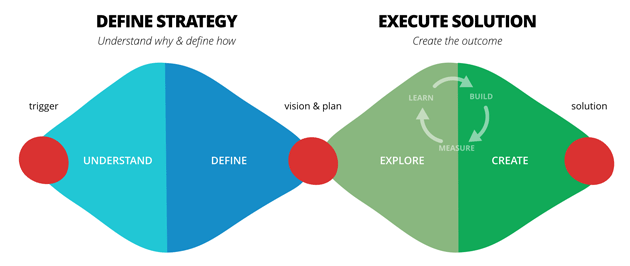
Dealing with Ideas
Do you have a great idea for a product that could make millions? Chances are the answer is yes. Everyone has a great idea up their sleeve. But not everyone has made millions of dollars from them. In fact, far more people have lost money on an idea than have made it.
Why is that? Quite simply, ideas are free. Delivering them is expensive and hard.
Anyone can come up with a great idea without putting in any effort. Inspiration striking in the shower does not lead directly to making money. Ideas have no value until they are turned into a successful product – which takes skill and hard work. Added to this is the challenge of identifying the good ideas from the bad. An inspired idea is not necessarily a profitable idea.
One of the keys to dealing with ideas is to minimize the amount of effort you invest until it’s proven to be a good one. The earlier you kill bad ideas, the less money you pour down the drain.
The lean startup culture has popularized methods for doing this. Minimum viable products, the build-measure-learn cycle and pivoting. These all focus on minimizing the amount of money invested into an idea. They are all about proving or invalidating an idea as quickly and as cheaply as possible.
This same principle applies in larger established companies as well. It’s just not as diligently used. Without the pressure of limited capital to burn through there is less pressure to be lean. Often new projects kicked-off without a validated purpose and defined measures of success. Nor are lessons learnt from unsuccessful projects.
All in all this leads to lots of time and money spent on ideas that should never have become more than a scribble on a piece of paper.
So how do you deal with and manage ideas? How do you sort the good from the bad? These simple practices can help minimize the investment in bad ideas and maximize the focus on the best ones.

Start by Taking 20 Minutes to Define the Idea
Before spending any time talking about an idea, take some time to define what it is and what problem it is going to solve. Some time doesn’t mean hours or days. That’s too much investment. Taking 20 minutes is enough to make sure the idea has been thought through, but not so much you become attached to it.
This isn’t about introducing more bureaucracy. It’s about applying rigor. That little bit of time spent upfront allows informed and targeted decision-making.
Here some points to consider when defining an idea:
-
Why - What problem will it solve? What is its purpose? Which strategic goal will it support? A simple one-sentence problem statement provides a strong clarity of purpose.
-
Who - Who is the target audience? Who will use the outcomes of this initiative? These could be either internal or external customers.
-
How – What are the goals? What behaviours need to be changed? What will a successful outcome look like? This isn’t about diving into the detail, it’s about defining the proposed method of solving the problem.
-
Measures of Success - How will we measure if this idea successfully delivers value? How will we know when it is done? Clear, quantifiable metrics are important to measure how effective an idea is. Avoid trying to use general measures (such as NPS), which are affected by various factors. What is your One Metric That Matters? The more a particular impact can be isolated, the clearer the results will be. If you cannot identify a specific measure then you should question the business value of an idea.
-
When – Are there any particular dates or timeframes in which this initiative needs to be completed? What are the consequences or risks of delaying it? Measure the Cost of Delay.
-
Resources – What skills or resources are required to deliver the idea? Quantities aren’t required at the idea stage. Flagging which resources or other areas of the business will be needed helps inform decision-making.
Defining these details shouldn’t be a long exercise at the idea stage. A simple one-pager with a few dot points on each of these is enough to inform a discussion.
Prioritise Your Ideas
Create a backlog of ideas and with a clear view of which is the highest priority to start working on next. When new ideas come up evaluate them against the existing priorities. Either bump something else down this list or put the new idea in a parking lot.
As part of your prioritisation process you should stop more ideas than you start. People coming up with ideas is a good thing, but it shouldn’t be a given that they will be worked on.
A regular ‘idea pitch’ session is a good way of discussing and prioritising ideas against each other. This doesn’t have to be a long drawn out process. Once you get good at it, this can be a 10 minute conversation. If it needs to take longer, then it is time well spent.
If you are starting a program of work use a simple planning poker exercise to establish priorities, just as you would with features and epics. Use the simple calculation to measure value:

This quantified value will allow you to prioritise an objective value rather than the HiPPO decision-making principle.
Prioritise Ideas Along with Other Work
When resources become available decide whether to explore a new idea or start a different piece of work. If you have a program of work in play, it’s a simple matter of resource and backlog management. Exploring an idea doesn’t come for free. It takes times and resources. Time and resources that could deliver something else of value.
If a new idea comes up that is urgent, consider if should you stop something else already underway and reassign the resources. This comes with a context switching cost but is sometimes necessary as circumstances change.
What you shouldn’t do is just start working on a new idea top of the existing workload. If you do you should expect it to come at either a productivity or human cost. Having too much work in progress at one time reduces overall throughput and burns people out.
Spend Time Exploring the Problem Before Delivering the Idea
People often want to go straight from having a moment of inspiration to starting to build it. They skip the discovery phase and jump headlong into execution mode. This is a recipe for months of hard work spent on a project that doesn’t deliver the value it promised or tries to solve the wrong problem.
The first step in working on an idea is to understand the problem it aims to solve. With this clarity you are able to evaluate and select the best solution. A well-understood problem also provides clarity of purpose and helps focus the scope of work. It’s an important first step in starting any piece of work that is going to be successful.
A simple framework for understanding the different stages an idea goes through is the Double Diamond.

Ideas are the trigger that starts the process of defining the strategy. Take some time to understand and define the problem. This allows you to evaluate potential solutions and chose the right one.
This time spent in the initial discovery phase is a worthwhile investment that will save time. However, it doesn’t always have to be a lengthy process. Sometimes it can be an hour spent sketching on a whiteboard. Other times it could require months of research to explore and understand the problem. It all depends on the context and size of the idea.
It is important to be deliberate about which mode you are in. Are defining the idea, exploring the problem, or executing the solution? Your approach and tools should adapt accordingly.
Starting to Deliver an Idea / Switching to Delivery Mode
Once you’re ready to start executing the solution, you need to create a vision and plan. The best way to do this is with a collaborative kick-off workshop. Get the project team and stakeholders together in a room to discuss it and come up with a plan.
Start by revisiting the original idea brief. Share the Why, Who, How and Measures of success. Refine as necessary and reach agreement.
Then frame the workshop with a simple focusing question: What do we need to know to get started? Here are some of the subjects to cover:
-
Goals – What are the proposed outcomes of the project. It is important to prioritise these, as they might not all be required to drive the necessary change, nor feasible to aim for. SMART Criteria are a useful tool for defining these.
-
Target Audience – Use a tool such as Personas or Empathy Maps to create a shared understanding of who the target audience is.
-
Behaviours you Want to Change – Think about how you want your target audience to change their behaviour. This will make you think more laterally about possible solutions and priorities.
-
Features and Tasks – Define the pieces of work required to change the behaviours and influence the measures of success. Again, prioritisation is important for these.
-
Resources – Who, what and how much is required to deliver this piece of work. Once you have an estimate it’s important to revisit the question of whether the return on investment is worthwhile.
-
Iteration Plan – What is the project timeline, key dates, MVP, feature plan, etc.
-
RAIDs – What are Risks, Assumptions, Issues and Dependencies that the team needs to address and make stakeholders aware of.
Impact mapping is a useful tool for structuring these workshop activities.
Covering these will give everyone a shared mental model of the problem, goals and solution. It is the best way to prepare everyone to work together to build the idea and deliver a great result.
Disclaimer: The statements and opinions expressed in this article are those of the author(s) and do not necessarily reflect the positions of Thoughtworks.














